Post-Operative Nursing Care Plan for Sarah Brown: Analysis
VerifiedAdded on 2023/01/06
|11
|3105
|71
Report
AI Summary
This report presents a comprehensive nursing care plan for Sarah Brown, a 66-year-old patient who underwent an open right hemicolectomy. The report begins with an introduction to the role of nurses in surgical settings and then delves into Sarah's case, analyzing her co-morbidities, including smoking, cardiac heart disease, and obstructive sleep apnea (OSA). It identifies potential clinical complications, specifically focusing on pain and hypertension, and discusses the relevant nursing assessments and interventions to mitigate these risks. The report emphasizes the importance of post-operative assessment and provides rationales for nursing actions, supported by academic literature. Furthermore, the report outlines a detailed discharge plan for Sarah, including post-operative education on medication, prevention of complications, psychosocial issues, and lifestyle modifications. The report concludes with a summary of the key findings and recommendations for Sarah's post-operative care.

Nursing the Surgical Patient
Paraphrase This Document
Need a fresh take? Get an instant paraphrase of this document with our AI Paraphraser

Table of Contents
Introduction......................................................................................................................................1
PART A...........................................................................................................................................1
Part B: Analysing and discussing the case to identify potential clinical issues...............................4
Discuss Sarah’s co-morbidities including smoking, cardiac heart disease, obstructive sleep
apnoea (OSA) (previous MI, hypertension and hypercholesterolemia) in the context of having
a general anaesthetic (GA) and specific to the 24 hour postoperative period........................4
Choose TWO (2) potential clinical complications related to the co-morbidities that could
arise in the 24 hour period......................................................................................................5
Discuss the relevant assessment/s and interventions the nurse would initiate to identify and
prevent clinical deterioration. Provide rationales for your actions/ interventions and support
with academic literature.........................................................................................................6
Part C: Discharge planning..............................................................................................................7
Plan and prioritise discharge advice and a plan for Sarah......................................................7
In the discharge plan, consider the appropriate post-operative education for Sarah including
the surgical procedure. Concisely provide a discharge plan and education around medication,
prevention of post-operative complications, psychosocial issues, and lifestyle modification7
Refrain from merely providing generic information. Be succinct and appropriate in your
advice but also critically evaluate the information in the case and specifically relate this to
your discharge plan.................................................................................................................8
Conclusion.......................................................................................................................................8
References........................................................................................................................................9
Introduction......................................................................................................................................1
PART A...........................................................................................................................................1
Part B: Analysing and discussing the case to identify potential clinical issues...............................4
Discuss Sarah’s co-morbidities including smoking, cardiac heart disease, obstructive sleep
apnoea (OSA) (previous MI, hypertension and hypercholesterolemia) in the context of having
a general anaesthetic (GA) and specific to the 24 hour postoperative period........................4
Choose TWO (2) potential clinical complications related to the co-morbidities that could
arise in the 24 hour period......................................................................................................5
Discuss the relevant assessment/s and interventions the nurse would initiate to identify and
prevent clinical deterioration. Provide rationales for your actions/ interventions and support
with academic literature.........................................................................................................6
Part C: Discharge planning..............................................................................................................7
Plan and prioritise discharge advice and a plan for Sarah......................................................7
In the discharge plan, consider the appropriate post-operative education for Sarah including
the surgical procedure. Concisely provide a discharge plan and education around medication,
prevention of post-operative complications, psychosocial issues, and lifestyle modification7
Refrain from merely providing generic information. Be succinct and appropriate in your
advice but also critically evaluate the information in the case and specifically relate this to
your discharge plan.................................................................................................................8
Conclusion.......................................................................................................................................8
References........................................................................................................................................9
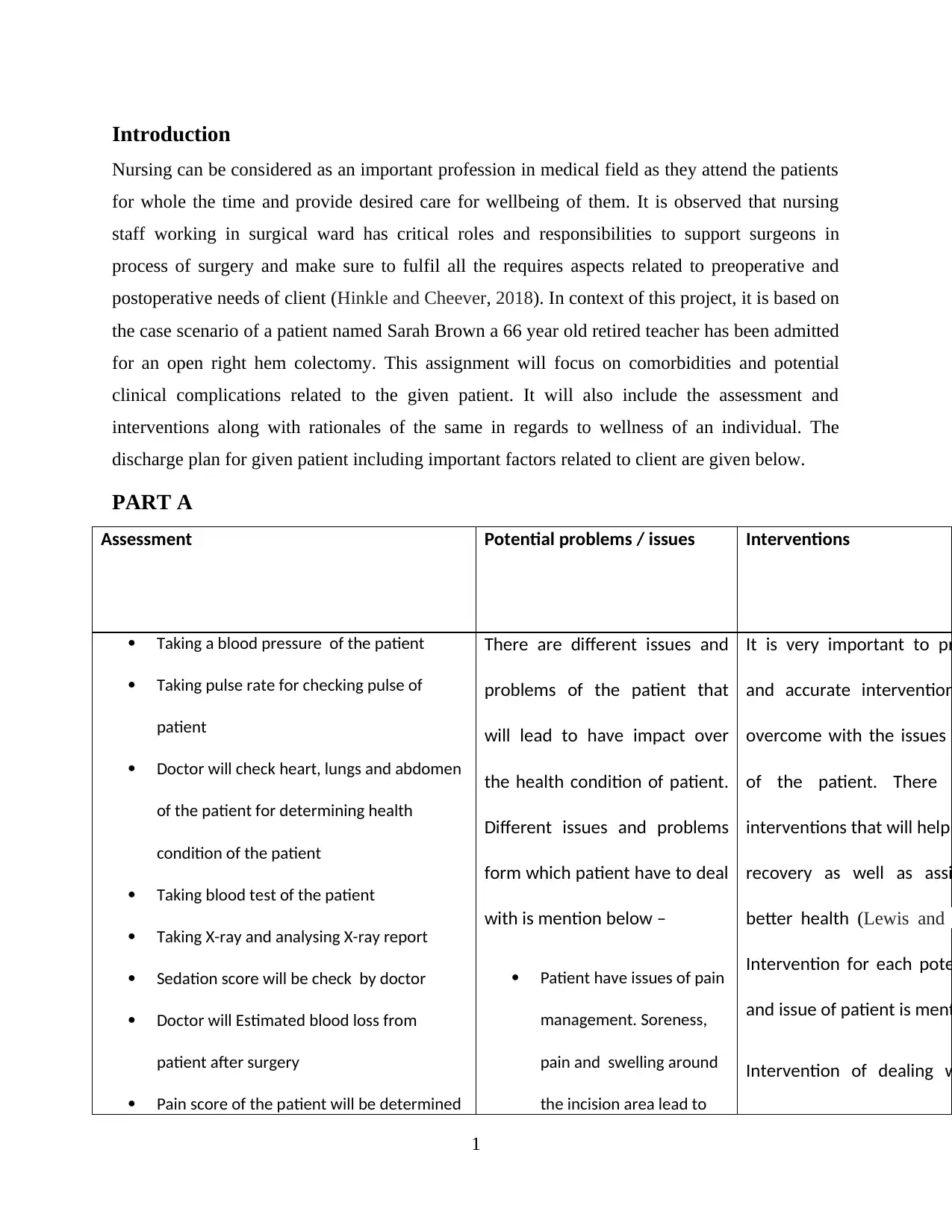
Introduction
Nursing can be considered as an important profession in medical field as they attend the patients
for whole the time and provide desired care for wellbeing of them. It is observed that nursing
staff working in surgical ward has critical roles and responsibilities to support surgeons in
process of surgery and make sure to fulfil all the requires aspects related to preoperative and
postoperative needs of client (Hinkle and Cheever, 2018). In context of this project, it is based on
the case scenario of a patient named Sarah Brown a 66 year old retired teacher has been admitted
for an open right hem colectomy. This assignment will focus on comorbidities and potential
clinical complications related to the given patient. It will also include the assessment and
interventions along with rationales of the same in regards to wellness of an individual. The
discharge plan for given patient including important factors related to client are given below.
PART A
Assessment Potential problems / issues Interventions
Taking a blood pressure of the patient
Taking pulse rate for checking pulse of
patient
Doctor will check heart, lungs and abdomen
of the patient for determining health
condition of the patient
Taking blood test of the patient
Taking X-ray and analysing X-ray report
Sedation score will be check by doctor
Doctor will Estimated blood loss from
patient after surgery
Pain score of the patient will be determined
There are different issues and
problems of the patient that
will lead to have impact over
the health condition of patient.
Different issues and problems
form which patient have to deal
with is mention below –
Patient have issues of pain
management. Soreness,
pain and swelling around
the incision area lead to
It is very important to pr
and accurate intervention
overcome with the issues
of the patient. There
interventions that will help
recovery as well as assi
better health (Lewis and
Intervention for each pote
and issue of patient is menti
Intervention of dealing w
1
Nursing can be considered as an important profession in medical field as they attend the patients
for whole the time and provide desired care for wellbeing of them. It is observed that nursing
staff working in surgical ward has critical roles and responsibilities to support surgeons in
process of surgery and make sure to fulfil all the requires aspects related to preoperative and
postoperative needs of client (Hinkle and Cheever, 2018). In context of this project, it is based on
the case scenario of a patient named Sarah Brown a 66 year old retired teacher has been admitted
for an open right hem colectomy. This assignment will focus on comorbidities and potential
clinical complications related to the given patient. It will also include the assessment and
interventions along with rationales of the same in regards to wellness of an individual. The
discharge plan for given patient including important factors related to client are given below.
PART A
Assessment Potential problems / issues Interventions
Taking a blood pressure of the patient
Taking pulse rate for checking pulse of
patient
Doctor will check heart, lungs and abdomen
of the patient for determining health
condition of the patient
Taking blood test of the patient
Taking X-ray and analysing X-ray report
Sedation score will be check by doctor
Doctor will Estimated blood loss from
patient after surgery
Pain score of the patient will be determined
There are different issues and
problems of the patient that
will lead to have impact over
the health condition of patient.
Different issues and problems
form which patient have to deal
with is mention below –
Patient have issues of pain
management. Soreness,
pain and swelling around
the incision area lead to
It is very important to pr
and accurate intervention
overcome with the issues
of the patient. There
interventions that will help
recovery as well as assi
better health (Lewis and
Intervention for each pote
and issue of patient is menti
Intervention of dealing w
1
⊘ This is a preview!⊘
Do you want full access?
Subscribe today to unlock all pages.

Trusted by 1+ million students worldwide
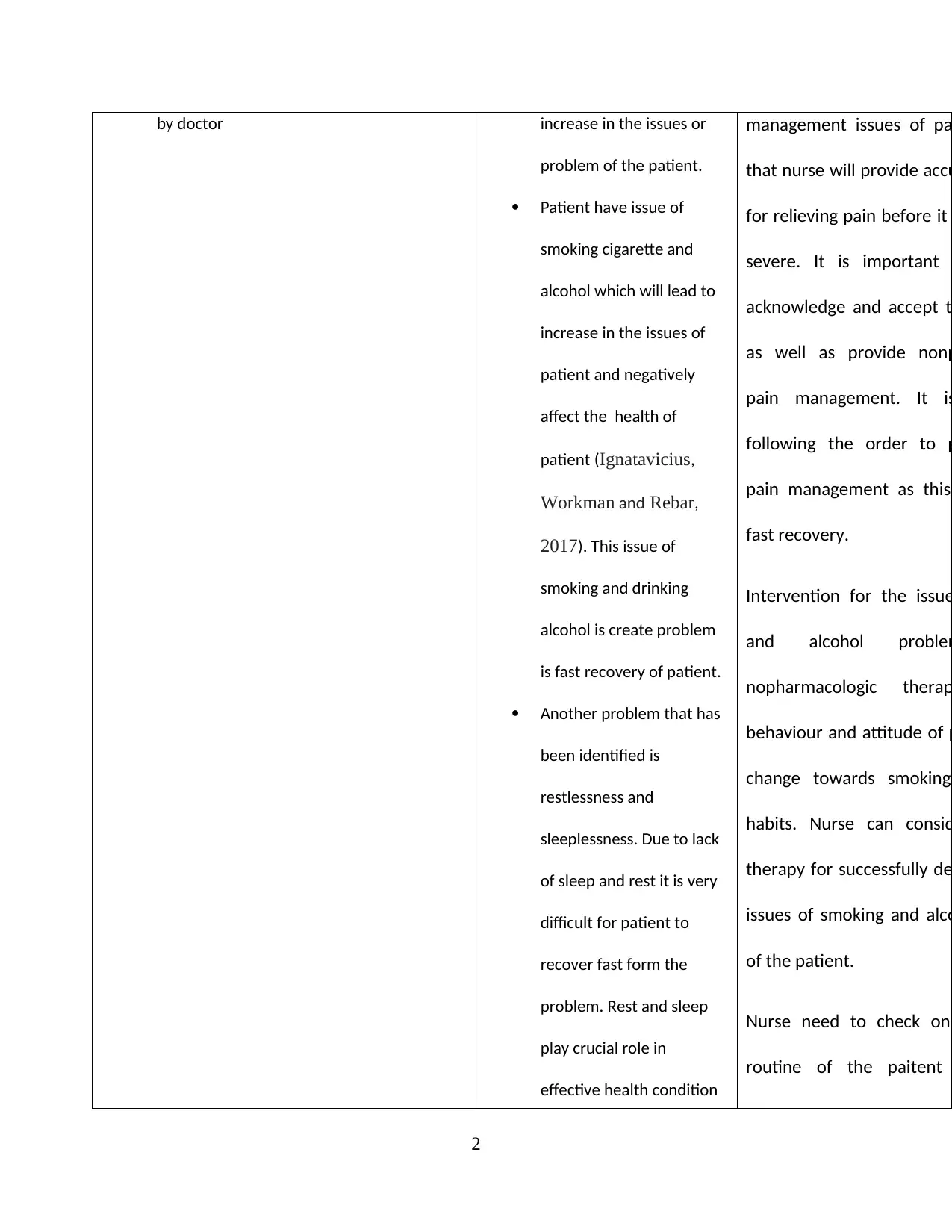
by doctor increase in the issues or
problem of the patient.
Patient have issue of
smoking cigarette and
alcohol which will lead to
increase in the issues of
patient and negatively
affect the health of
patient (Ignatavicius,
Workman and Rebar,
2017). This issue of
smoking and drinking
alcohol is create problem
is fast recovery of patient.
Another problem that has
been identified is
restlessness and
sleeplessness. Due to lack
of sleep and rest it is very
difficult for patient to
recover fast form the
problem. Rest and sleep
play crucial role in
effective health condition
management issues of pa
that nurse will provide accu
for relieving pain before it
severe. It is important
acknowledge and accept th
as well as provide nonp
pain management. It is
following the order to p
pain management as this
fast recovery.
Intervention for the issue
and alcohol problem
nopharmacologic therap
behaviour and attitude of p
change towards smoking
habits. Nurse can consid
therapy for successfully de
issues of smoking and alco
of the patient.
Nurse need to check on
routine of the paitent
2
problem of the patient.
Patient have issue of
smoking cigarette and
alcohol which will lead to
increase in the issues of
patient and negatively
affect the health of
patient (Ignatavicius,
Workman and Rebar,
2017). This issue of
smoking and drinking
alcohol is create problem
is fast recovery of patient.
Another problem that has
been identified is
restlessness and
sleeplessness. Due to lack
of sleep and rest it is very
difficult for patient to
recover fast form the
problem. Rest and sleep
play crucial role in
effective health condition
management issues of pa
that nurse will provide accu
for relieving pain before it
severe. It is important
acknowledge and accept th
as well as provide nonp
pain management. It is
following the order to p
pain management as this
fast recovery.
Intervention for the issue
and alcohol problem
nopharmacologic therap
behaviour and attitude of p
change towards smoking
habits. Nurse can consid
therapy for successfully de
issues of smoking and alco
of the patient.
Nurse need to check on
routine of the paitent
2
Paraphrase This Document
Need a fresh take? Get an instant paraphrase of this document with our AI Paraphraser
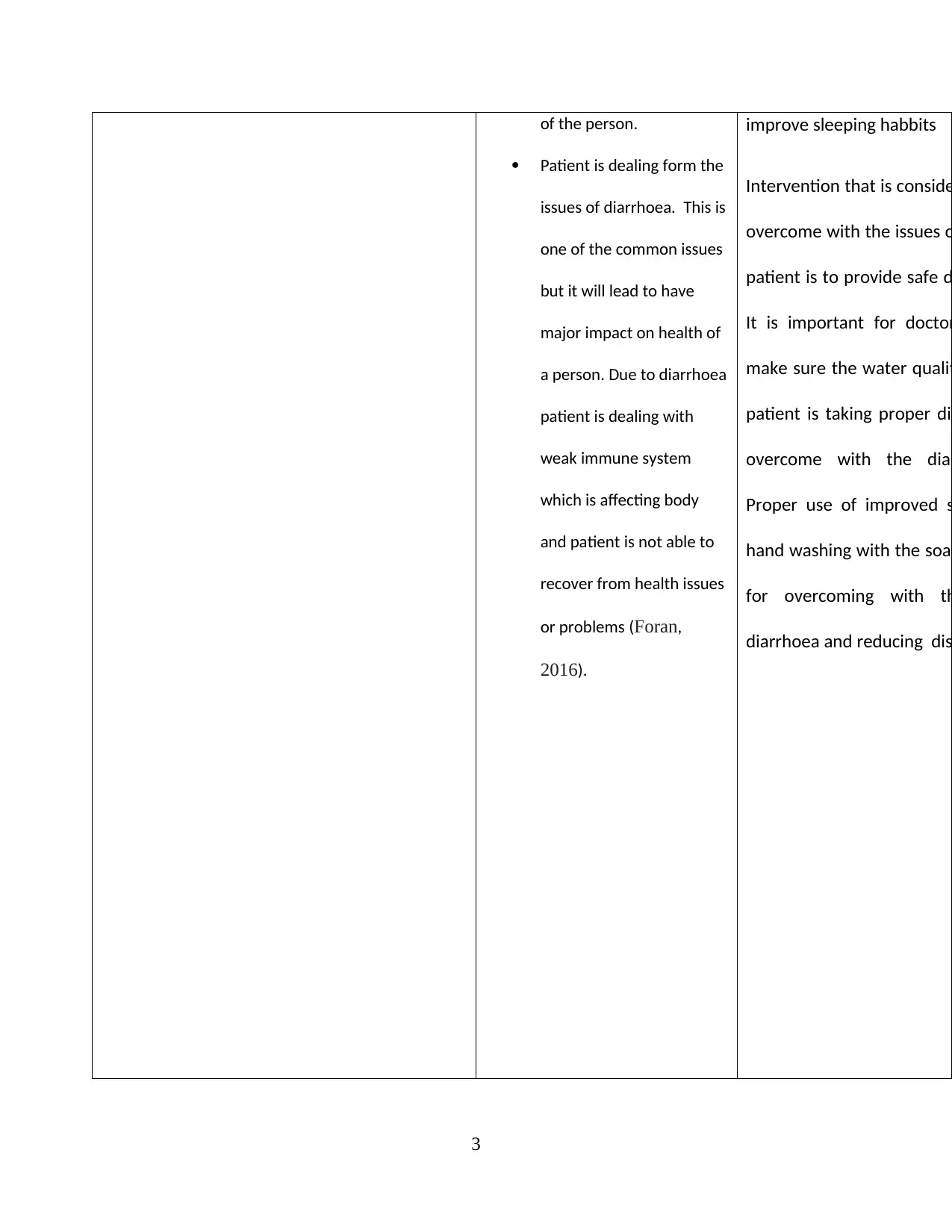
of the person.
Patient is dealing form the
issues of diarrhoea. This is
one of the common issues
but it will lead to have
major impact on health of
a person. Due to diarrhoea
patient is dealing with
weak immune system
which is affecting body
and patient is not able to
recover from health issues
or problems (Foran,
2016).
improve sleeping habbits
Intervention that is conside
overcome with the issues o
patient is to provide safe d
It is important for doctor
make sure the water qualit
patient is taking proper die
overcome with the diar
Proper use of improved s
hand washing with the soap
for overcoming with th
diarrhoea and reducing dis
3
Patient is dealing form the
issues of diarrhoea. This is
one of the common issues
but it will lead to have
major impact on health of
a person. Due to diarrhoea
patient is dealing with
weak immune system
which is affecting body
and patient is not able to
recover from health issues
or problems (Foran,
2016).
improve sleeping habbits
Intervention that is conside
overcome with the issues o
patient is to provide safe d
It is important for doctor
make sure the water qualit
patient is taking proper die
overcome with the diar
Proper use of improved s
hand washing with the soap
for overcoming with th
diarrhoea and reducing dis
3
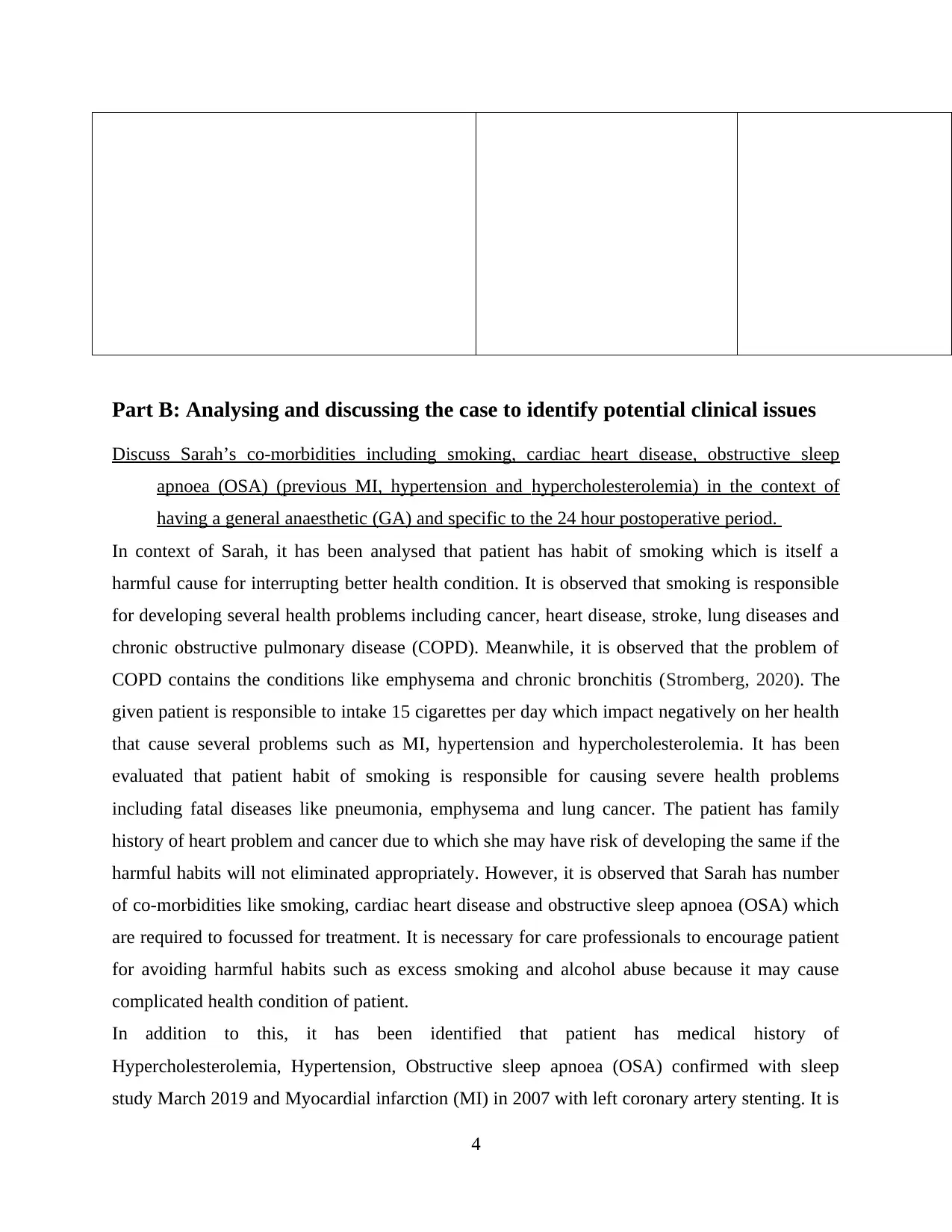
Part B: Analysing and discussing the case to identify potential clinical issues
Discuss Sarah’s co-morbidities including smoking, cardiac heart disease, obstructive sleep
apnoea (OSA) (previous MI, hypertension and hypercholesterolemia) in the context of
having a general anaesthetic (GA) and specific to the 24 hour postoperative period.
In context of Sarah, it has been analysed that patient has habit of smoking which is itself a
harmful cause for interrupting better health condition. It is observed that smoking is responsible
for developing several health problems including cancer, heart disease, stroke, lung diseases and
chronic obstructive pulmonary disease (COPD). Meanwhile, it is observed that the problem of
COPD contains the conditions like emphysema and chronic bronchitis (Stromberg, 2020). The
given patient is responsible to intake 15 cigarettes per day which impact negatively on her health
that cause several problems such as MI, hypertension and hypercholesterolemia. It has been
evaluated that patient habit of smoking is responsible for causing severe health problems
including fatal diseases like pneumonia, emphysema and lung cancer. The patient has family
history of heart problem and cancer due to which she may have risk of developing the same if the
harmful habits will not eliminated appropriately. However, it is observed that Sarah has number
of co-morbidities like smoking, cardiac heart disease and obstructive sleep apnoea (OSA) which
are required to focussed for treatment. It is necessary for care professionals to encourage patient
for avoiding harmful habits such as excess smoking and alcohol abuse because it may cause
complicated health condition of patient.
In addition to this, it has been identified that patient has medical history of
Hypercholesterolemia, Hypertension, Obstructive sleep apnoea (OSA) confirmed with sleep
study March 2019 and Myocardial infarction (MI) in 2007 with left coronary artery stenting. It is
4
Discuss Sarah’s co-morbidities including smoking, cardiac heart disease, obstructive sleep
apnoea (OSA) (previous MI, hypertension and hypercholesterolemia) in the context of
having a general anaesthetic (GA) and specific to the 24 hour postoperative period.
In context of Sarah, it has been analysed that patient has habit of smoking which is itself a
harmful cause for interrupting better health condition. It is observed that smoking is responsible
for developing several health problems including cancer, heart disease, stroke, lung diseases and
chronic obstructive pulmonary disease (COPD). Meanwhile, it is observed that the problem of
COPD contains the conditions like emphysema and chronic bronchitis (Stromberg, 2020). The
given patient is responsible to intake 15 cigarettes per day which impact negatively on her health
that cause several problems such as MI, hypertension and hypercholesterolemia. It has been
evaluated that patient habit of smoking is responsible for causing severe health problems
including fatal diseases like pneumonia, emphysema and lung cancer. The patient has family
history of heart problem and cancer due to which she may have risk of developing the same if the
harmful habits will not eliminated appropriately. However, it is observed that Sarah has number
of co-morbidities like smoking, cardiac heart disease and obstructive sleep apnoea (OSA) which
are required to focussed for treatment. It is necessary for care professionals to encourage patient
for avoiding harmful habits such as excess smoking and alcohol abuse because it may cause
complicated health condition of patient.
In addition to this, it has been identified that patient has medical history of
Hypercholesterolemia, Hypertension, Obstructive sleep apnoea (OSA) confirmed with sleep
study March 2019 and Myocardial infarction (MI) in 2007 with left coronary artery stenting. It is
4
⊘ This is a preview!⊘
Do you want full access?
Subscribe today to unlock all pages.

Trusted by 1+ million students worldwide

observed that pervious health problems may develop again with extremely severe form due to
excess use of smoking or alcohol (Jones and et. al., 2020). However, the health condition of
Sarah is complicated and it is required for her to manage her lifestyle and avoid smoking and
alcohol to remain healthy along with taking proper medication.
Choose TWO (2) potential clinical complications related to the co-morbidities that could arise in
the 24 hour period.
Considering the given case scenario, it has been analysed that clinical complications are required
to be examined in order to treat the same on time. It includes the fact that some of potential
clinical complications may occur after completion of surgery which generally consist the high
level of pain and infection on surgical site due to which early interventions are required.
However, it has been evaluated that Sarah has harmful habits like smoking and alcohol intake
which may impact the post-surgical condition of patient that may cause severe complications for
them. It is favourable for care professionals to remain prepared to deal with complications
effectively and immediately to make patient condition stable (Fernández-Garrido and Cauli,
2017). In given case of Sarah, it has been analysed that the potential clinical complications
includes two problem such as level of pain and acquiring the sever condition of hypertension
which is required to be treated by proper efforts of medical practitioners. It is required for them
to assess the condition of people in order to improve the clinical condition of patient by
providing appropriate care and medication to manage stable health condition respectively.
On the other hand, it has been determined that the surgical patient has mainly problem of pain
which becomes severe many times then care professional should monitor the condition on
regular basis. It is necessary for them to monitor the condition by keeping patient under
observation for required duration of time (Gumus and Aydın, 2020). It is necessary to carry out
regular observation for long time if the surgery is complicated and patient is facing more
difficulty after operation. However, Sarah has previous medical history of hypertension which
can be in treated to acquire severe form then required medication should be provided to patient in
order to manage her blood pressure normal.
5
excess use of smoking or alcohol (Jones and et. al., 2020). However, the health condition of
Sarah is complicated and it is required for her to manage her lifestyle and avoid smoking and
alcohol to remain healthy along with taking proper medication.
Choose TWO (2) potential clinical complications related to the co-morbidities that could arise in
the 24 hour period.
Considering the given case scenario, it has been analysed that clinical complications are required
to be examined in order to treat the same on time. It includes the fact that some of potential
clinical complications may occur after completion of surgery which generally consist the high
level of pain and infection on surgical site due to which early interventions are required.
However, it has been evaluated that Sarah has harmful habits like smoking and alcohol intake
which may impact the post-surgical condition of patient that may cause severe complications for
them. It is favourable for care professionals to remain prepared to deal with complications
effectively and immediately to make patient condition stable (Fernández-Garrido and Cauli,
2017). In given case of Sarah, it has been analysed that the potential clinical complications
includes two problem such as level of pain and acquiring the sever condition of hypertension
which is required to be treated by proper efforts of medical practitioners. It is required for them
to assess the condition of people in order to improve the clinical condition of patient by
providing appropriate care and medication to manage stable health condition respectively.
On the other hand, it has been determined that the surgical patient has mainly problem of pain
which becomes severe many times then care professional should monitor the condition on
regular basis. It is necessary for them to monitor the condition by keeping patient under
observation for required duration of time (Gumus and Aydın, 2020). It is necessary to carry out
regular observation for long time if the surgery is complicated and patient is facing more
difficulty after operation. However, Sarah has previous medical history of hypertension which
can be in treated to acquire severe form then required medication should be provided to patient in
order to manage her blood pressure normal.
5
Paraphrase This Document
Need a fresh take? Get an instant paraphrase of this document with our AI Paraphraser
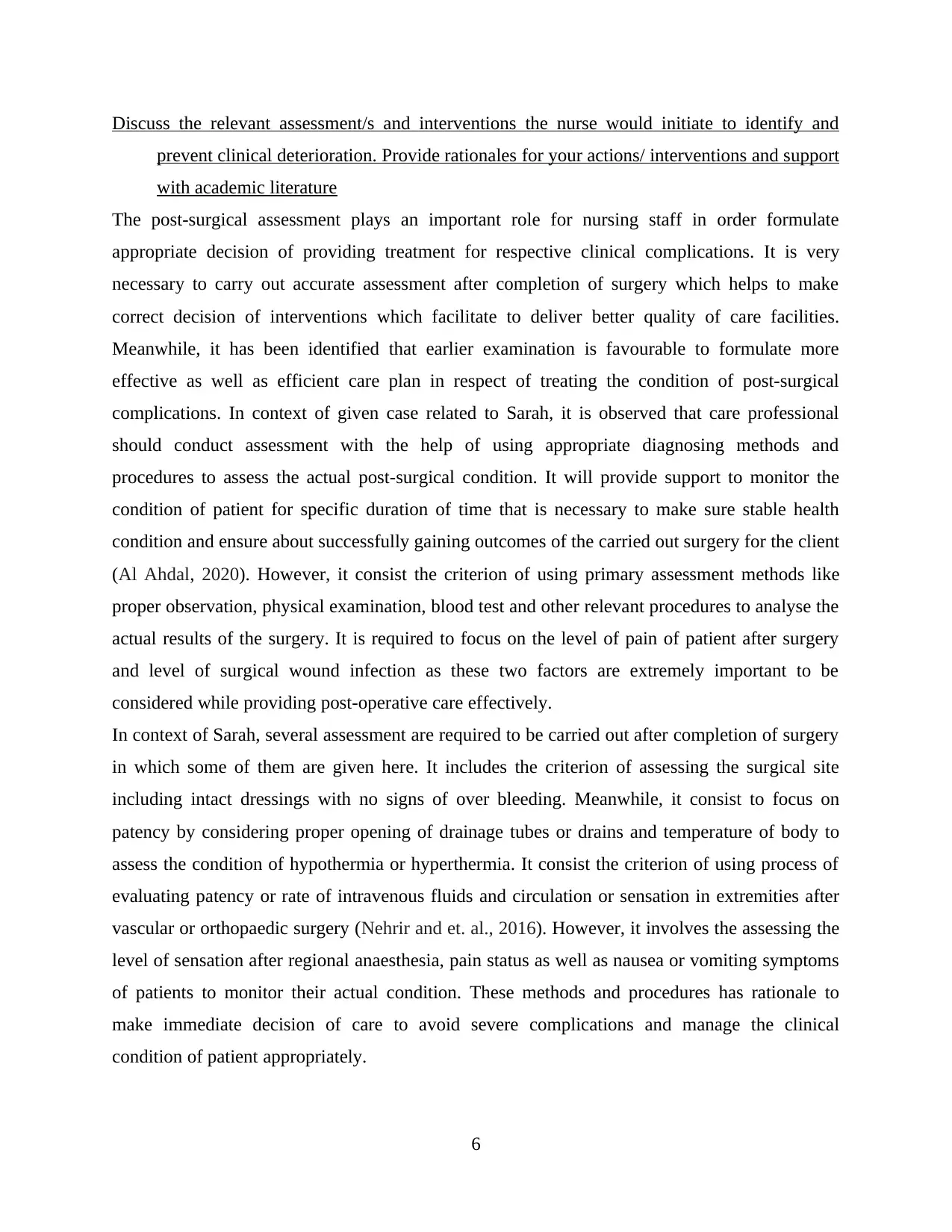
Discuss the relevant assessment/s and interventions the nurse would initiate to identify and
prevent clinical deterioration. Provide rationales for your actions/ interventions and support
with academic literature
The post-surgical assessment plays an important role for nursing staff in order formulate
appropriate decision of providing treatment for respective clinical complications. It is very
necessary to carry out accurate assessment after completion of surgery which helps to make
correct decision of interventions which facilitate to deliver better quality of care facilities.
Meanwhile, it has been identified that earlier examination is favourable to formulate more
effective as well as efficient care plan in respect of treating the condition of post-surgical
complications. In context of given case related to Sarah, it is observed that care professional
should conduct assessment with the help of using appropriate diagnosing methods and
procedures to assess the actual post-surgical condition. It will provide support to monitor the
condition of patient for specific duration of time that is necessary to make sure stable health
condition and ensure about successfully gaining outcomes of the carried out surgery for the client
(Al Ahdal, 2020). However, it consist the criterion of using primary assessment methods like
proper observation, physical examination, blood test and other relevant procedures to analyse the
actual results of the surgery. It is required to focus on the level of pain of patient after surgery
and level of surgical wound infection as these two factors are extremely important to be
considered while providing post-operative care effectively.
In context of Sarah, several assessment are required to be carried out after completion of surgery
in which some of them are given here. It includes the criterion of assessing the surgical site
including intact dressings with no signs of over bleeding. Meanwhile, it consist to focus on
patency by considering proper opening of drainage tubes or drains and temperature of body to
assess the condition of hypothermia or hyperthermia. It consist the criterion of using process of
evaluating patency or rate of intravenous fluids and circulation or sensation in extremities after
vascular or orthopaedic surgery (Nehrir and et. al., 2016). However, it involves the assessing the
level of sensation after regional anaesthesia, pain status as well as nausea or vomiting symptoms
of patients to monitor their actual condition. These methods and procedures has rationale to
make immediate decision of care to avoid severe complications and manage the clinical
condition of patient appropriately.
6
prevent clinical deterioration. Provide rationales for your actions/ interventions and support
with academic literature
The post-surgical assessment plays an important role for nursing staff in order formulate
appropriate decision of providing treatment for respective clinical complications. It is very
necessary to carry out accurate assessment after completion of surgery which helps to make
correct decision of interventions which facilitate to deliver better quality of care facilities.
Meanwhile, it has been identified that earlier examination is favourable to formulate more
effective as well as efficient care plan in respect of treating the condition of post-surgical
complications. In context of given case related to Sarah, it is observed that care professional
should conduct assessment with the help of using appropriate diagnosing methods and
procedures to assess the actual post-surgical condition. It will provide support to monitor the
condition of patient for specific duration of time that is necessary to make sure stable health
condition and ensure about successfully gaining outcomes of the carried out surgery for the client
(Al Ahdal, 2020). However, it consist the criterion of using primary assessment methods like
proper observation, physical examination, blood test and other relevant procedures to analyse the
actual results of the surgery. It is required to focus on the level of pain of patient after surgery
and level of surgical wound infection as these two factors are extremely important to be
considered while providing post-operative care effectively.
In context of Sarah, several assessment are required to be carried out after completion of surgery
in which some of them are given here. It includes the criterion of assessing the surgical site
including intact dressings with no signs of over bleeding. Meanwhile, it consist to focus on
patency by considering proper opening of drainage tubes or drains and temperature of body to
assess the condition of hypothermia or hyperthermia. It consist the criterion of using process of
evaluating patency or rate of intravenous fluids and circulation or sensation in extremities after
vascular or orthopaedic surgery (Nehrir and et. al., 2016). However, it involves the assessing the
level of sensation after regional anaesthesia, pain status as well as nausea or vomiting symptoms
of patients to monitor their actual condition. These methods and procedures has rationale to
make immediate decision of care to avoid severe complications and manage the clinical
condition of patient appropriately.
6
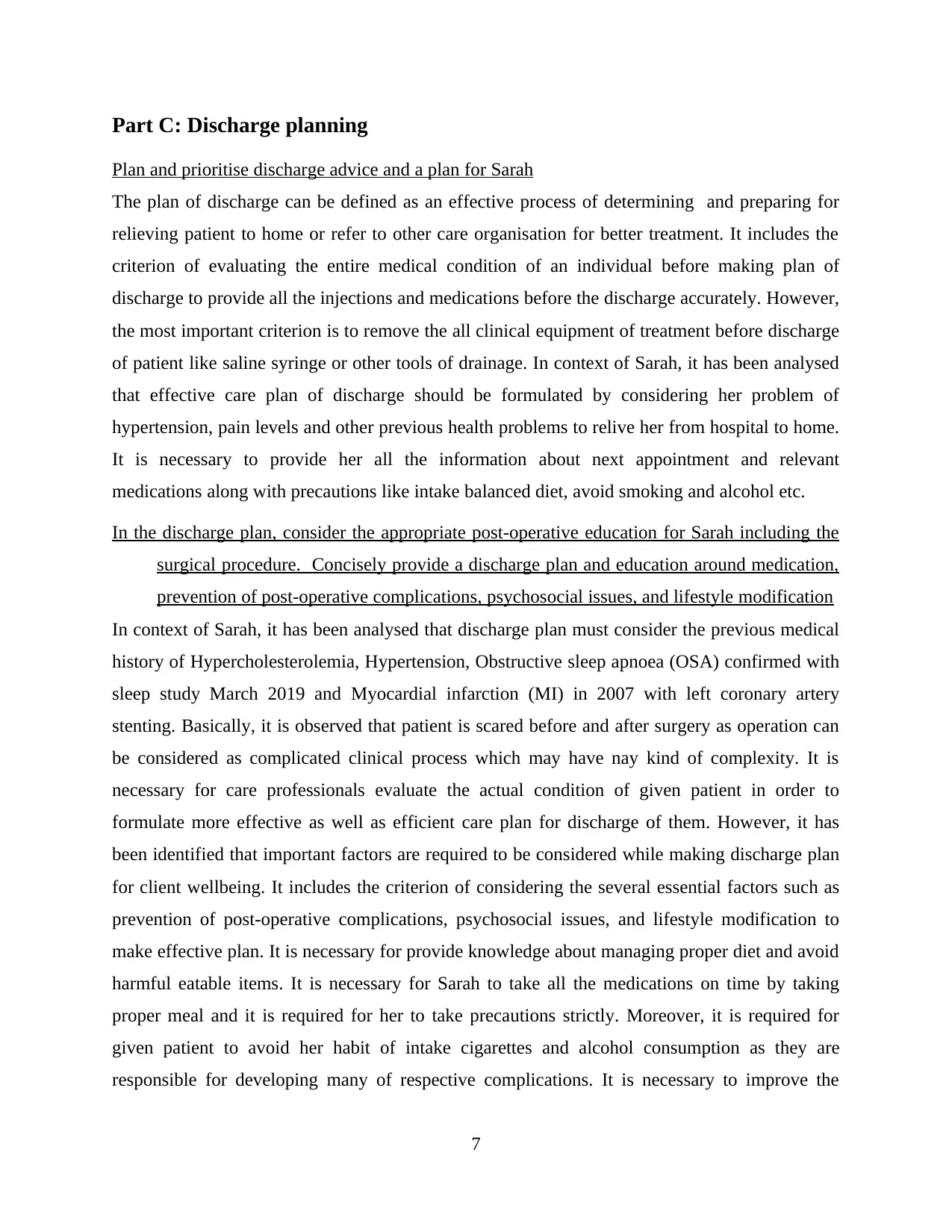
Part C: Discharge planning
Plan and prioritise discharge advice and a plan for Sarah
The plan of discharge can be defined as an effective process of determining and preparing for
relieving patient to home or refer to other care organisation for better treatment. It includes the
criterion of evaluating the entire medical condition of an individual before making plan of
discharge to provide all the injections and medications before the discharge accurately. However,
the most important criterion is to remove the all clinical equipment of treatment before discharge
of patient like saline syringe or other tools of drainage. In context of Sarah, it has been analysed
that effective care plan of discharge should be formulated by considering her problem of
hypertension, pain levels and other previous health problems to relive her from hospital to home.
It is necessary to provide her all the information about next appointment and relevant
medications along with precautions like intake balanced diet, avoid smoking and alcohol etc.
In the discharge plan, consider the appropriate post-operative education for Sarah including the
surgical procedure. Concisely provide a discharge plan and education around medication,
prevention of post-operative complications, psychosocial issues, and lifestyle modification
In context of Sarah, it has been analysed that discharge plan must consider the previous medical
history of Hypercholesterolemia, Hypertension, Obstructive sleep apnoea (OSA) confirmed with
sleep study March 2019 and Myocardial infarction (MI) in 2007 with left coronary artery
stenting. Basically, it is observed that patient is scared before and after surgery as operation can
be considered as complicated clinical process which may have nay kind of complexity. It is
necessary for care professionals evaluate the actual condition of given patient in order to
formulate more effective as well as efficient care plan for discharge of them. However, it has
been identified that important factors are required to be considered while making discharge plan
for client wellbeing. It includes the criterion of considering the several essential factors such as
prevention of post-operative complications, psychosocial issues, and lifestyle modification to
make effective plan. It is necessary for provide knowledge about managing proper diet and avoid
harmful eatable items. It is necessary for Sarah to take all the medications on time by taking
proper meal and it is required for her to take precautions strictly. Moreover, it is required for
given patient to avoid her habit of intake cigarettes and alcohol consumption as they are
responsible for developing many of respective complications. It is necessary to improve the
7
Plan and prioritise discharge advice and a plan for Sarah
The plan of discharge can be defined as an effective process of determining and preparing for
relieving patient to home or refer to other care organisation for better treatment. It includes the
criterion of evaluating the entire medical condition of an individual before making plan of
discharge to provide all the injections and medications before the discharge accurately. However,
the most important criterion is to remove the all clinical equipment of treatment before discharge
of patient like saline syringe or other tools of drainage. In context of Sarah, it has been analysed
that effective care plan of discharge should be formulated by considering her problem of
hypertension, pain levels and other previous health problems to relive her from hospital to home.
It is necessary to provide her all the information about next appointment and relevant
medications along with precautions like intake balanced diet, avoid smoking and alcohol etc.
In the discharge plan, consider the appropriate post-operative education for Sarah including the
surgical procedure. Concisely provide a discharge plan and education around medication,
prevention of post-operative complications, psychosocial issues, and lifestyle modification
In context of Sarah, it has been analysed that discharge plan must consider the previous medical
history of Hypercholesterolemia, Hypertension, Obstructive sleep apnoea (OSA) confirmed with
sleep study March 2019 and Myocardial infarction (MI) in 2007 with left coronary artery
stenting. Basically, it is observed that patient is scared before and after surgery as operation can
be considered as complicated clinical process which may have nay kind of complexity. It is
necessary for care professionals evaluate the actual condition of given patient in order to
formulate more effective as well as efficient care plan for discharge of them. However, it has
been identified that important factors are required to be considered while making discharge plan
for client wellbeing. It includes the criterion of considering the several essential factors such as
prevention of post-operative complications, psychosocial issues, and lifestyle modification to
make effective plan. It is necessary for provide knowledge about managing proper diet and avoid
harmful eatable items. It is necessary for Sarah to take all the medications on time by taking
proper meal and it is required for her to take precautions strictly. Moreover, it is required for
given patient to avoid her habit of intake cigarettes and alcohol consumption as they are
responsible for developing many of respective complications. It is necessary to improve the
7
⊘ This is a preview!⊘
Do you want full access?
Subscribe today to unlock all pages.

Trusted by 1+ million students worldwide
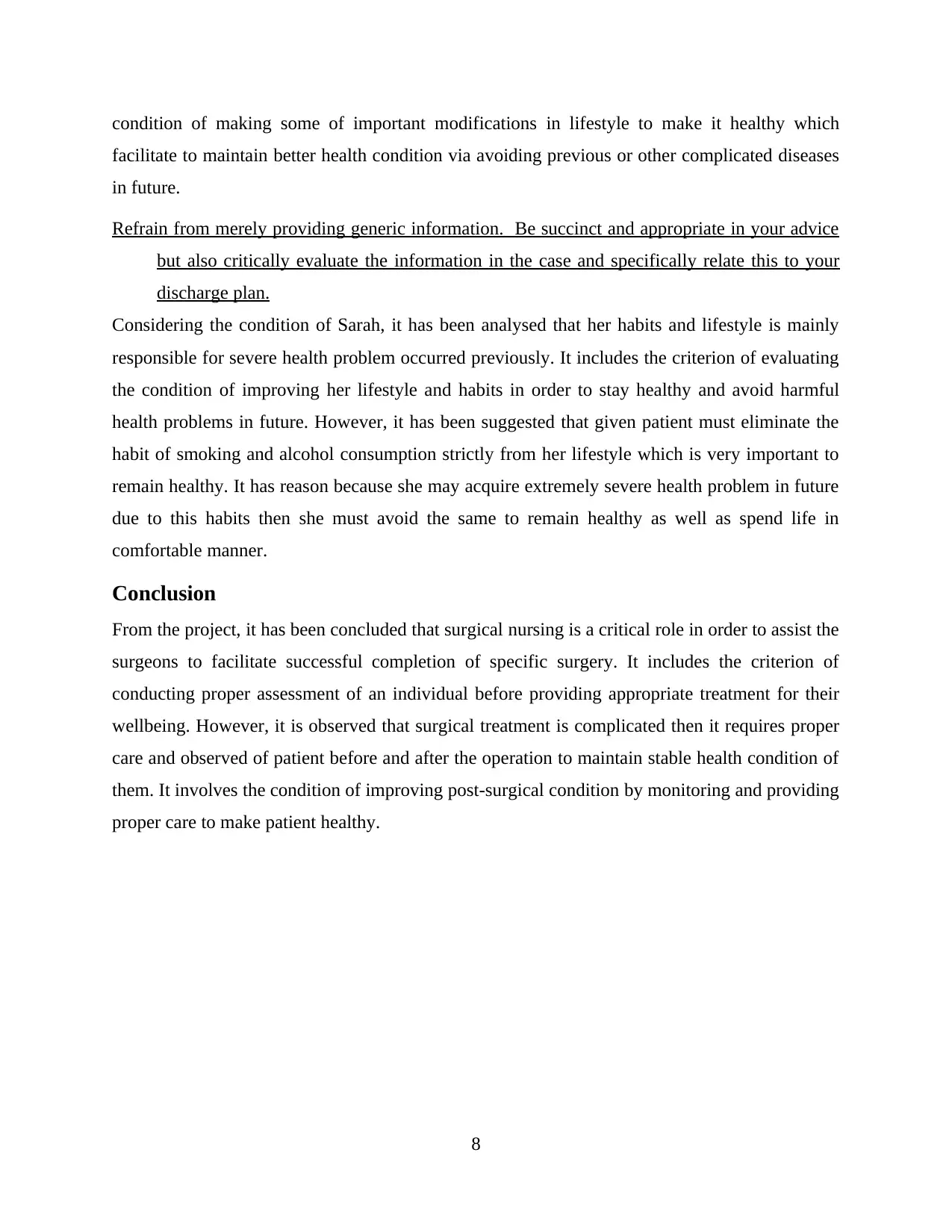
condition of making some of important modifications in lifestyle to make it healthy which
facilitate to maintain better health condition via avoiding previous or other complicated diseases
in future.
Refrain from merely providing generic information. Be succinct and appropriate in your advice
but also critically evaluate the information in the case and specifically relate this to your
discharge plan.
Considering the condition of Sarah, it has been analysed that her habits and lifestyle is mainly
responsible for severe health problem occurred previously. It includes the criterion of evaluating
the condition of improving her lifestyle and habits in order to stay healthy and avoid harmful
health problems in future. However, it has been suggested that given patient must eliminate the
habit of smoking and alcohol consumption strictly from her lifestyle which is very important to
remain healthy. It has reason because she may acquire extremely severe health problem in future
due to this habits then she must avoid the same to remain healthy as well as spend life in
comfortable manner.
Conclusion
From the project, it has been concluded that surgical nursing is a critical role in order to assist the
surgeons to facilitate successful completion of specific surgery. It includes the criterion of
conducting proper assessment of an individual before providing appropriate treatment for their
wellbeing. However, it is observed that surgical treatment is complicated then it requires proper
care and observed of patient before and after the operation to maintain stable health condition of
them. It involves the condition of improving post-surgical condition by monitoring and providing
proper care to make patient healthy.
8
facilitate to maintain better health condition via avoiding previous or other complicated diseases
in future.
Refrain from merely providing generic information. Be succinct and appropriate in your advice
but also critically evaluate the information in the case and specifically relate this to your
discharge plan.
Considering the condition of Sarah, it has been analysed that her habits and lifestyle is mainly
responsible for severe health problem occurred previously. It includes the criterion of evaluating
the condition of improving her lifestyle and habits in order to stay healthy and avoid harmful
health problems in future. However, it has been suggested that given patient must eliminate the
habit of smoking and alcohol consumption strictly from her lifestyle which is very important to
remain healthy. It has reason because she may acquire extremely severe health problem in future
due to this habits then she must avoid the same to remain healthy as well as spend life in
comfortable manner.
Conclusion
From the project, it has been concluded that surgical nursing is a critical role in order to assist the
surgeons to facilitate successful completion of specific surgery. It includes the criterion of
conducting proper assessment of an individual before providing appropriate treatment for their
wellbeing. However, it is observed that surgical treatment is complicated then it requires proper
care and observed of patient before and after the operation to maintain stable health condition of
them. It involves the condition of improving post-surgical condition by monitoring and providing
proper care to make patient healthy.
8
Paraphrase This Document
Need a fresh take? Get an instant paraphrase of this document with our AI Paraphraser
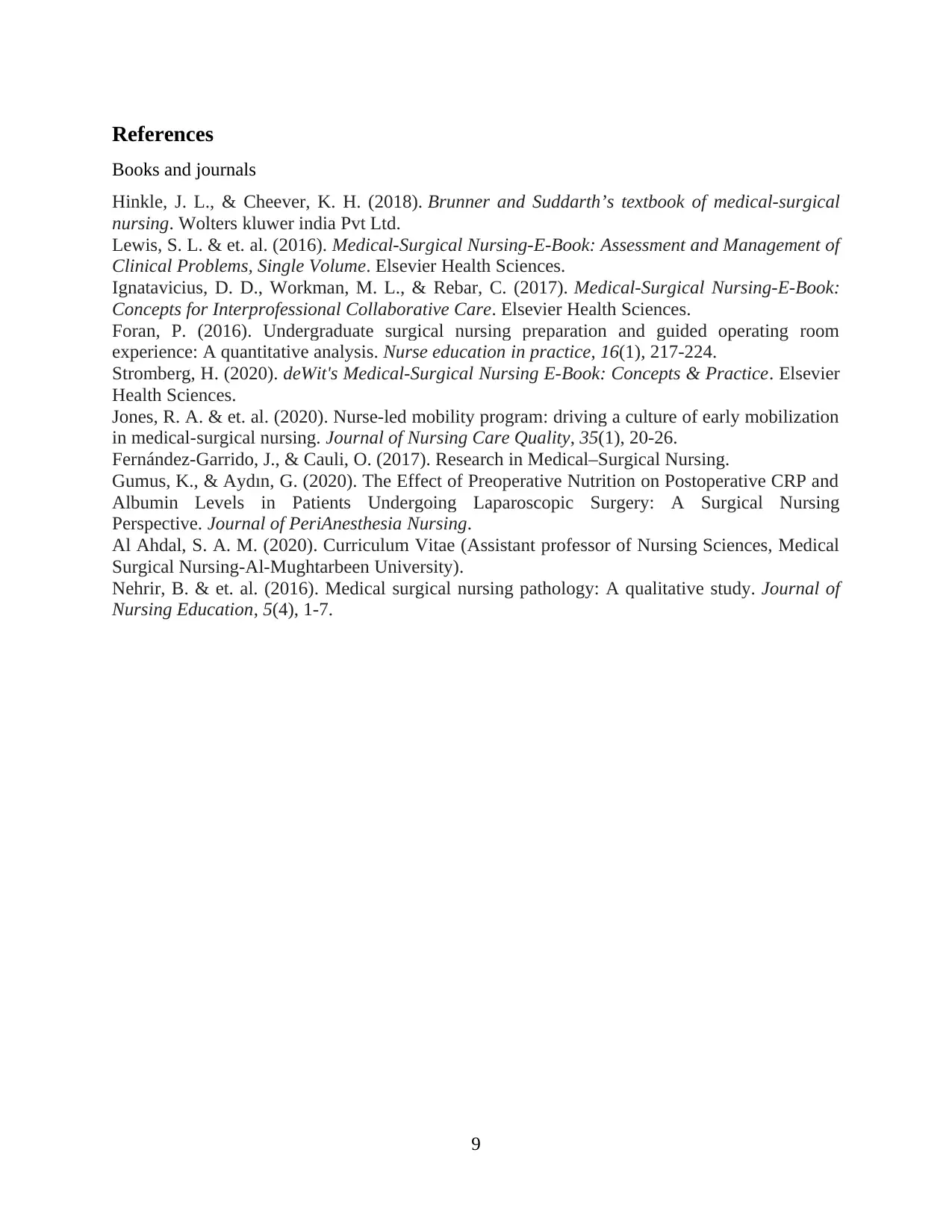
References
Books and journals
Hinkle, J. L., & Cheever, K. H. (2018). Brunner and Suddarth’s textbook of medical-surgical
nursing. Wolters kluwer india Pvt Ltd.
Lewis, S. L. & et. al. (2016). Medical-Surgical Nursing-E-Book: Assessment and Management of
Clinical Problems, Single Volume. Elsevier Health Sciences.
Ignatavicius, D. D., Workman, M. L., & Rebar, C. (2017). Medical-Surgical Nursing-E-Book:
Concepts for Interprofessional Collaborative Care. Elsevier Health Sciences.
Foran, P. (2016). Undergraduate surgical nursing preparation and guided operating room
experience: A quantitative analysis. Nurse education in practice, 16(1), 217-224.
Stromberg, H. (2020). deWit's Medical-Surgical Nursing E-Book: Concepts & Practice. Elsevier
Health Sciences.
Jones, R. A. & et. al. (2020). Nurse-led mobility program: driving a culture of early mobilization
in medical-surgical nursing. Journal of Nursing Care Quality, 35(1), 20-26.
Fernández-Garrido, J., & Cauli, O. (2017). Research in Medical–Surgical Nursing.
Gumus, K., & Aydın, G. (2020). The Effect of Preoperative Nutrition on Postoperative CRP and
Albumin Levels in Patients Undergoing Laparoscopic Surgery: A Surgical Nursing
Perspective. Journal of PeriAnesthesia Nursing.
Al Ahdal, S. A. M. (2020). Curriculum Vitae (Assistant professor of Nursing Sciences, Medical
Surgical Nursing-Al-Mughtarbeen University).
Nehrir, B. & et. al. (2016). Medical surgical nursing pathology: A qualitative study. Journal of
Nursing Education, 5(4), 1-7.
9
Books and journals
Hinkle, J. L., & Cheever, K. H. (2018). Brunner and Suddarth’s textbook of medical-surgical
nursing. Wolters kluwer india Pvt Ltd.
Lewis, S. L. & et. al. (2016). Medical-Surgical Nursing-E-Book: Assessment and Management of
Clinical Problems, Single Volume. Elsevier Health Sciences.
Ignatavicius, D. D., Workman, M. L., & Rebar, C. (2017). Medical-Surgical Nursing-E-Book:
Concepts for Interprofessional Collaborative Care. Elsevier Health Sciences.
Foran, P. (2016). Undergraduate surgical nursing preparation and guided operating room
experience: A quantitative analysis. Nurse education in practice, 16(1), 217-224.
Stromberg, H. (2020). deWit's Medical-Surgical Nursing E-Book: Concepts & Practice. Elsevier
Health Sciences.
Jones, R. A. & et. al. (2020). Nurse-led mobility program: driving a culture of early mobilization
in medical-surgical nursing. Journal of Nursing Care Quality, 35(1), 20-26.
Fernández-Garrido, J., & Cauli, O. (2017). Research in Medical–Surgical Nursing.
Gumus, K., & Aydın, G. (2020). The Effect of Preoperative Nutrition on Postoperative CRP and
Albumin Levels in Patients Undergoing Laparoscopic Surgery: A Surgical Nursing
Perspective. Journal of PeriAnesthesia Nursing.
Al Ahdal, S. A. M. (2020). Curriculum Vitae (Assistant professor of Nursing Sciences, Medical
Surgical Nursing-Al-Mughtarbeen University).
Nehrir, B. & et. al. (2016). Medical surgical nursing pathology: A qualitative study. Journal of
Nursing Education, 5(4), 1-7.
9
1 out of 11
Related Documents
Your All-in-One AI-Powered Toolkit for Academic Success.
+13062052269
info@desklib.com
Available 24*7 on WhatsApp / Email
![[object Object]](/_next/static/media/star-bottom.7253800d.svg)
Unlock your academic potential
Copyright © 2020–2026 A2Z Services. All Rights Reserved. Developed and managed by ZUCOL.





